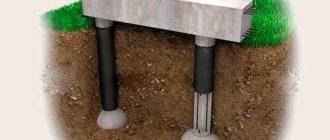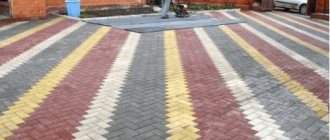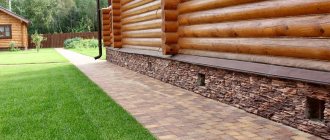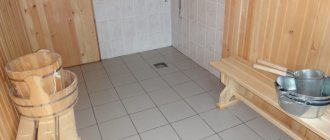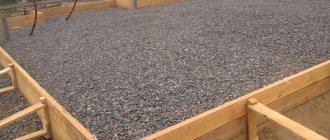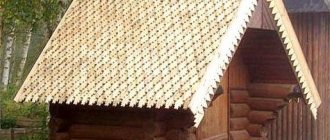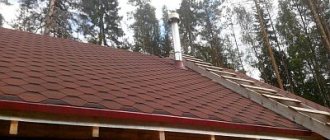What is paving stone and what types does it come in?
A parallelepiped made of stone is called a paving stone. The coating is strong, durable, laid out on the surface block by block, and is intended for beautifying the external space. It can be clinker, granite, concrete. The elements are different in shape, decor, color. There are many installation methods and technologies for performing work.
Laying granite paving stones is suitable for sidewalks and roads. Natural material is environmentally friendly and does not require constant maintenance. Concrete blocks are also popular; they are distinguished by high levels of stability, but it is worth considering the material’s susceptibility to acids. Clinker paving stones are durable, do not deteriorate from chemicals, and do not fade.
For a budget option, you can make paths using vibro-pressed cement-polymer paving stones. The material tolerates loads well and is moisture and frost resistant. The low price is due to the replacement of cement components with polymer ones.
There are several tips when choosing. In addition to the type and shape of the elements, it is worth paying attention to the technical characteristics of the compositions. Frost resistance is important, which takes into account the freezing-thawing cycle (for the climatic conditions of Russia this is 10 cycles). Water absorption capacity should be no more than 2%. There are 3 strength indicators for paving stones: compression, bending and abrasion. Average weight of material per 1 sq. m - 100 kg.
What are the advantages and disadvantages
The advantage of paving stones is strength, high performance characteristics, high load-bearing capacity, and resistance to temperature changes. The material is easy to install, so you can make the paving yourself. Paving stones are environmentally friendly, have high maintainability, and do not require high operating costs.
Paths made of paving stones do not retain water; the safety of people's movement is ensured by the rough texture of the elements. A geotextile separator, which is laid in the base, prevents soil subsidence and deformation of the sidewalk.
The disadvantage is the high cost of paving stones, which is why concrete-polymer block options are used in budget projects at the dacha. Paving stones are also difficult to process.
On some soils, with a high level of humidity, the base can be washed out, then the masonry sags and individual elements fall out.
Types of paving slabs with their pros and cons
Modern manufacturers of building materials produce paving stones using various modern technologies. Depending on the characteristics of the technological process, sidewalk tiles are divided into 3 types:
- vibration-cast;
- vibropressed.
Vibrocast tiles are produced using plastic compounds . The “filling” of the building material is poured using equipment into special containers – “vibroforms”. Paving slabs of this type have an attractive appearance; they imitate natural wood or brick. Most often, this type of building material is used for individual construction. Vibro-cast tile elements are used for arranging personal plots of country houses and cottages. They are also laid out on paths located in parks and garden plots.
Vibropressed tiles are made in a different way. The pre-prepared concrete mixture is poured into a special mold. After this, it is subjected to pressure, which is created by special equipment - a brick press. Thanks to a special manufacturing technology, the building material has a strict shape with a rough surface. Vibropressed tiles are used to lay sidewalks, pavements, squares and roads in crowded and public places.
Read on topic: Construction of high-speed highways
Modern consumers have access to a large number of product options in a variety of colors. Paving slabs also come in various shapes; the most popular are the following shaped paving elements:
- honeycomb;
- paving stones;
- scales;
- clover;
- wave;
- fleece;
- gzhelka;
- flower.
Depending on the material from which paving slabs are made, they are divided into several types. Relatively inexpensive building materials made of concrete and clay are popular among modern consumers. In the arrangement of suburban areas, clay paving slabs imitating roofing tiles are often used. To improve the technical characteristics of the building material, manufacturers can add a binder material, for example, granite chips, to the tiles.
The most wear-resistant are granite tiles , characterized by the excellent strength characteristics of natural stone. It easily tolerates sudden temperature changes, due to which it has a long service life. Concrete slabs become unusable after 3-4 years, asphalt pavement will begin to deform after 2 years, and granite tiles will last more than 25 years. Another plus of granite is that it does not require additional means of protection against damage. The disadvantage of natural building materials is their high cost.
Marking paths and platforms
The technology for laying paving stones on sand involves marking the area. First, the paving area is calculated. At this stage, it is necessary to measure the width of the road so that the bars lie evenly and do not require modification. The thickness of the seams is also measured. For marking, pegs are installed in the corners of the future sidewalk. Beacon cords are needed to check the level of the road surface. Adjustment is also necessary for laying rainwater drains.
Configurations and forms
The shape of the paving stones can be any, you just have to choose the most suitable option for yourself. If you use rectangular products, the path will look like brickwork. Another good option is paving stones made in the form of a coil. Radius and square options are also popular.
The process of laying paving stones
Excavation
Laying paving stones yourself involves excavation work. To create a trench, soil is removed, since the top layer of earth is often unstable and will not be able to withstand massive elements and operational loads.
The volume of soil to be lifted depends on the project, but there are general rules. The paving stones should be located 4 cm below the area adjacent to the sidewalk. The total depth of the trench for the blocks and fastening mixture is from 20 cm. If the tiles are placed on a platform for transport, it is necessary to increase the depth of the trench by 10 cm. The bottom of the earthen structure is leveled and compacted with a manual tamper or a vibrating plate.
Features of choosing paving stones
Nowadays the construction market offers a wide range of road surfaces. The owner of the site must, first of all, decide which area he is going to pave. The aesthetic and performance characteristics of the bars directly depend on this.
Parameters that determine the purpose of the material:
Thickness
- Bars up to 30 mm thick are suitable exclusively for pedestrian areas.
- Park areas and recreational areas with increased traffic are paved with elements from 50 to 60 mm.
- For the construction of access roads and parking for cars and trucks, stones over 80 mm are used.
Advice from the experts! When purchasing a batch of bars, knock the tiles together. A dull sound indicates that the production technology of the product has been violated (insufficient drying).
Also, the product must be accompanied by a quality certificate, which reflects such characteristics as:
- Frost resistance. The indicator indicates the number of freezing and thawing cycles that the bars can withstand. For example, in the middle zone, temperature changes vary from - 25 ° C to + 25 ° C, with a frequency of 5 to 7 times. This means that the service life of tiles with a frost resistance of 200 and with 5 cycles of temperature changes will be equal to 40 years.
- Strength. Strength indicators are assessed according to three criteria: bending (resistance to oblique loads, value from 60 kg/cm²), compression (impact of vertical loads with a value from 400 kg/cm²), abrasion (for paving stones this indicator should be less than or equal to 0.4 kg/cm2).
- Water absorption. The indicator is measured as a percentage. Moreover, the lower it is, the better. For example, if the value is 1.5%, then in this case the material will absorb water at the rate of 15 g per 1 kg of paving stone weight.
Form
Decorative wave paving stones
The configuration of the elements does not affect the strength of the paving stones. Therefore, the choice of decorative elements depends on the personal preferences of the owner of the site.
Landscape designers recommend selecting several coating options. The original composition will enliven the area.
The construction market offers decorative tiles in the shape of clover, wave, parquet or honeycomb.
You can lay the bars according to your own sketch, or contact the designers.
Laying technology
Options for laying paving stones are determined by the use of different materials and block shapes, and the purpose of the road. The elements are placed on a base made of sand, concrete or cement-sand. The rectangular classic layout of sidewalk fragments allows you to combine colors and textures.
The herringbone laying technology is performed by laying tiles at an angle of 45° or 90°. When laying out a checkerboard pattern, square bars of contrasting shades are used and the elements are placed in a checkerboard pattern. The “random mixture” technique allows you to design a path with a random arrangement of bars of different sizes and colors.
On a crushed stone base
The technology of laying paving stones on a crushed stone base includes a complex of works. A geogrid is placed on the cleared space, a layer of crushed stone of 10-20 cm is applied on top. A slope is created on the leveled mixture, and the surface is compacted. Then the curbs are installed and secured with a dry cement-sand mixture. Also, in areas of high loads, installation of a road mesh will be required. Stone bars are installed according to the sketch, gaps of up to 3 cm are left between the blocks. The seams between the bars are filled with a dry mixture.
Made from concrete
A concrete base for the blocks is required to strengthen the base. The bonding mixture is necessary when working with thin tiles and constructing sidewalks on moving soil. Laying paving stones over concrete involves installing formwork into which concrete is poured. For large areas of coverage, it will be necessary to install expansion joints every 3 m.
After grouting the joints and installing curbs, pour a 3 cm layer of cement-sand mixture. The elements of the road surface are laid out on the surface. Concrete paving stones are not damaged by strong weight and mechanical loads.
On the sand layer
To form a sidewalk from paving stones on a sandy base, you need to prepare the surface: level it, cover it with geo-textile, form a sand cushion up to 15 cm. It is important what kind of sand is used in the work. Experts recommend formulations without impurities.
The embankment is leveled and a slope is created for water flow. The base is watered and compacted with a vibrating plate. The curbs are fastened with a mixture of concrete, then the laying of paving stones begins according to a given pattern. The gaps between masonry elements should be 2-3 mm. The seams are filled with sand, then the sidewalk is compacted with a vibrating plate and cleaned with water.
Nuances
Methods for installing bars and materials are determined by the purpose of the road. For pedestrian sidewalks, 40 mm tiles are sufficient. A road with constant vehicle traffic is paved with thick paving stones. To create pedestrian paths, a pattern of blocks is laid out on a sand base or a mixture of sand and cement. The methods of laying paving stones also determine the types of loads on the road surface. The coating can be strengthened using a concrete screed.
What are the benefits of concrete paving stones?
It is no coincidence that the products are actively used for paving paths and constructing parking lots. This is due to their excellent performance characteristics:
- high strength and wear resistance, allowing to withstand the constant movement of a large number of people and vehicles (even trucks);
- resistance to the external environment: sunlight, temperature changes, precipitation and wind;
- durability;
- environmental safety.
Concrete paving slabs
The material can be reused many times. Unlike asphalt, paving stones do not react to heat. And for its use in regions with cold climates, special additives are added to the composition to increase frost resistance.
In addition to functionality, the material also has decent aesthetic characteristics, allowing you to create not only a practical, but also an externally attractive coating. What is very convenient is that you can lay paving stones yourself, without resorting to the services of specialists. It is important to decide on the design in advance.
Paving slabs “Roman beech”
Paving options
- When placing products in the direction of movement, the path looks dynamic.
- Laying the slabs crosswise creates the impression of staticity and solidity.
- Decorative paving looks very aesthetically pleasing, in which the tiles are arranged in a circle or in a herringbone pattern.
A diagram of the installation of paving stones is shown in the photo.
Layout of paving stones
Installation of curbs
Installation of curbs occurs according to pre-made markings. Then a cement-sand mortar is mixed in a ratio of 1:3 and applied to the surface along the laying of the blocks. The curbs are placed on the bonding mixture and adjusted to the level. The finished slabs are left for 1 day so that the solution holds the elements together. In some design solutions, blocks are laid without a border.
What to consider when designing
We want to start step-by-step instructions for laying paving slabs with your own hands by creating a project. This is a really important stage. A correctly drawn up project will help you correctly calculate the required amount of materials, find the correct trajectory for the location of a path or platform, and choose an installation technology so that it will last for many years.
If you are designing a path, it is important to lay out a trajectory: this is done along the most “passable” sections. The location for the site is selected in accordance with the site plan. It is important that there are as few “dangerous” objects as possible on the path of the path or near the site (ideally, there should be none at all). Underground communications are considered potentially dangerous. If they are to be laid or repaired, all work must be completed before paving begins.
Close proximity of bushes or trees, especially large ones, is undesirable. Their root system will grow over time and begin to destroy the base of the structure. Therefore, young trees or seedlings need to be transplanted further away. Old trees may need to be removed. If you decide to leave them, build a new path or place the site at a distance of at least 3 m.
After selecting the installation site, the type and condition of the soil are assessed. If it is a relatively flat surface with normal load-bearing capacity, no additional work will have to be carried out. Loam, gravel or sandy loam are good bases. Silty or clayey soil will have to be additionally reinforced with a concrete base. Difficulties will also arise during construction on difficult terrain. Here it will be necessary to arrange flat terraces on which fragments of the path will be located.
Next, determine the size and shape of the paths or platforms. An important parameter is width. There are no strict requirements here, but if you are making a path from paving slabs with your own hands, it is important that it is comfortable for two pedestrians to walk on it and for them to pass easily. The average width is 100-120 cm. The width of the platform is determined depending on the purpose. Well, if it is a multiple of the width of the tile, then the amount of trimming will be significantly reduced.
Another important point is the arrangement of water drainage. Without it, rain and melt water will flow into the cracks between the elements, penetrate into the base and destroy it. Therefore, it is necessary to provide for a longitudinal or transverse slope of the structure. It should not be large: for longitudinal, 3-4˚ is enough, for transverse - 1-2˚. Small gaps can be provided to allow liquid to drain away.
Instagram domozmsk
Pixabay
- Landscape
How to make concrete paths at your dacha with your own hands
Geotextile layer
Preparation for installation of tiles includes laying a waterproofing layer, which is placed above the drainage as a substrate. This prevents moisture from reaching the top load-bearing layer and improves the quality and integrity of the coating. A layer of geotextile is lined on the bottom and walls of the earthen structure. The artificial material does not rot from prolonged exposure to water, does not decompose even with prolonged use, and provides the road with protection from water.
What does landscape design consist of?
When landscaping a site, owners of country houses take into account not only their financial capabilities, but also their personal needs and wishes. But at the same time, some nuances must be taken into account so that the result of the work done is truly pleasing to the eye.
Landscape design of a summer cottage
Pay close attention to what types of element groups exist and how they are arranged. In particular, these are:
- buildings (both commercial and residential);
- paths, platforms;
- lawn;
- technical elements (for example, irrigation system, lighting, etc.);
- green spaces;
- decorative elements, small architectural forms;
- artificial reservoirs.
Paving slabs in the landscape
Wooden gazebo with barbecue
The main function of garden paths is to provide access to certain objects; They also allow you to walk around the site. If the path is properly arranged, then you can move along it comfortably, without the risk of getting your shoes dirty. As a rule, paving stones and paving slabs are used for the installation.
Note! When choosing a coating, take into account the area of the site, what the walls of the buildings are lined with, and the characteristics of the material itself. Often different materials are combined, which allows you to show your design abilities.
Types of garden paths
Sealing and finishing work
To maintain the integrity of the coating, it is necessary to grout the joints that separate the blocks from each other. There are three main methods for sealing paving joints. The distance between the elements is filled with sand, poured with concrete mortar or rubbed with a concrete mixture. For pavements made of natural granite, sand and concrete mortar are suitable. For roads made of ceramic paving stones, it is better to use sand. The seams between the concrete blocks are rubbed with concrete mixture. Marble blocks can only be held together with sand-cement mortar.
After filling the masonry joints, excess material is removed with a broom or broom. Then the sidewalk is hosed down with water, the mixture hardens and firmly holds the blocks together. Cement-sand mortar is poured between the coating elements and left for bonding.
Tool for laying paving stones
To make the construction of paving stone paths neat and quick, you will need the following set of tools:
- Hydraulic building level (10 m). If you do not own a laser level, which costs a lot of money, buy a regular hydraulic level.
- Construction rack bubble level 1 meter long.
- Metal profile pipe with a cross section of 20 x 40 mm: 2 meter and 6 meter pieces.
- Steel pointed pins and wooden pegs.
- White nylon cord;
- Large rubber hammer. You need to buy one high-quality mallet or three Chinese ones, as they quickly fall apart.
- Master OK.
- Two different tape measures: 2 meter and 10 meter.
- A broom or broom to sweep the seams between the tiles.
- A clamp and a heavy 100 mm steel angle. From them you need to make a device for fastening the paving stones before cutting it
Securing paving stones with a cutting clamp
- A grinder equipped with a steel disk with a diameter of 230 mm. Only use a steel disc and not abrasive cutting wheels. It is better to buy a more expensive disk with normal quality, since cheap samples quickly become unusable and will have to be replaced.
Steel 230 mm disc for cutting stone and concrete products cuts paving stones without any problems
Useful tips and tricks for your device
Despite the fact that the technology for laying paving slabs is quite simple, pay attention to the following recommendations:
- When laying the coating on a concrete base, be sure to arrange a slope for rainwater runoff. You can use a longitudinal, transverse or transverse-longitudinal slope of the coating. The optimal slope is 1 cm per meter. As a result, water will not collect between the tiles and the concrete base, which will protect the coating from swelling. In this case, a gap for water drainage is made between the tile covering and the curb.
- The width of the track is selected as a multiple of the dimensions of one covering element. Do not think that large-sized products are installed faster. Due to their significant weight, they are more difficult to lift, move and level on the base.
- All underground communications on the site are laid before the construction of paths and driveways. Otherwise, the coating will have to be dismantled. If some communications are planned to be carried out in the future, then plastic pipes are laid under the path at the place where they are carried out (the cross-section is chosen based on the size of the communications).
- To prevent grass from growing between the individual covering elements in the future, a layer of geotextile is laid in front of the foundation.
- Laying the tile covering is carried out only on a dry base, so work is not carried out during or after rain.
- The base for the tiles is carefully leveled. To arrange the pillow, purified sand without impurities and clay is used.
- The size of the track is selected taking into account the selected covering elements. If you plan to make a pattern or ornament, then it is worth drawing a diagram in advance and calculating the width of the coating, taking into account the seams. The circular method of laying products will require cutting some elements to the desired size.
At the preparation stage, it is worth considering the coating pattern. The sketch will allow you to get an idea of the future creation and calculate the required number of elements of a particular color and configuration. If paving slabs are laid by a master, the price, of course, for paving with a pattern or ornament will be higher.
Advice! The most options for patterned layouts are obtained when using rectangular paving stones.
Requirements for a concrete base
Paving slabs must be installed on a fully formed surface. All work on removing vegetation cover, soil compaction, and planning is carried out in accordance with the requirements of SNiP 3.02.01-87. The key standard is to create a basic level surface.
In addition, it is necessary to maintain a slope, which ultimately should be at least 1.5 cm for every 3 m of the path length in the direction of the surface slope. The prepared base must be compacted. For these purposes, special equipment is used, not forgetting about the timely moistening of the individual layers of the foundation being constructed.
- Each base layer has its own thickness standards and compaction coefficients. According to the regulations, compacted sand is subject to sanitation (treatment with sterilizing special means).
- When arranging the foundation for pouring concrete, waterproofing must be laid. The density of the separating layer should be at least 120-150 microns. In the absence of geotextiles, dense polyethylene film with a minimum overlap of 15-20 cm should be used.
- According to the requirements of SNiP, it is necessary to use class B15 concrete mixture in the work. In this case, the optimal thickness of the concrete layer should be at least 15 cm.
- For reinforcement purposes, it is necessary to use reinforcement. Minimum reinforcement involves the use of a network with a wire diameter of 5 mm and cells of 15x15 cm. If the technology allows the replacement of reinforcement, metal fiber is added to the concrete (using fiber-reinforced concrete).
- Concrete aggregates can be washed or graded. In this case, the grain size should not exceed 2.5 cm. There should be no foreign inclusions on the surface layer of concrete. Its humidity should not exceed 5%.
- The width of the expansion joints located in the middle of the courts should be 2.5 cm. They are filled in accordance with building codes. To reduce surface tension, concrete is cut into cards using a shrink joint.
- Installation work is carried out in dry weather at a temperature not lower than +5 degrees Celsius. Within 7-10 days from the beginning of concrete hardening, the surface is protected from precipitation and moisture loss. Next, the optimal mode is maintained to increase the strength of the base.
- The evenness of the surface is controlled using a long 3-meter rod or rule. The standards allow a slight deviation: no more than 3 mm for every 3 m of length in any direction.
The drainage design is determined for each specific project individually. Drainage is a prerequisite for high-quality foundation preparation. This is necessary not only to remove moisture, but also to prevent soil erosion in the area where the tiles are laid. Waterproofing prevents water from entering from below.

